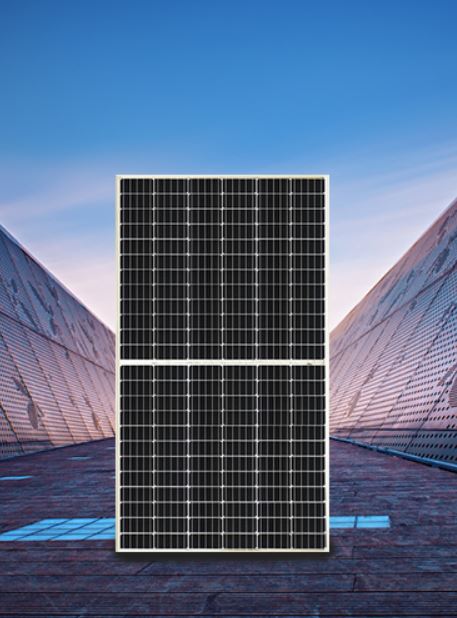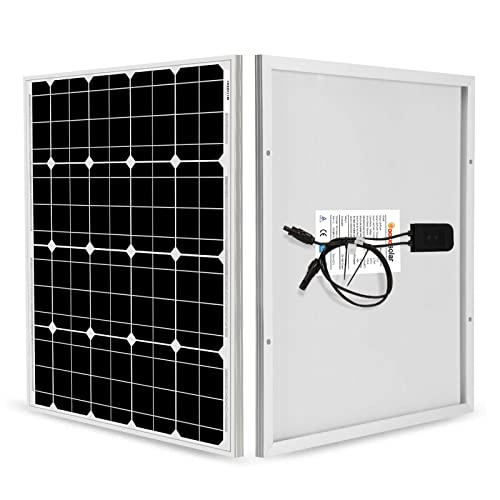SOLAR PANEL, 460Wp, 42V, monocrystalline
Outdated Article
SOLAR PANEL
Definition
Solar panels capture sunlight as a source of radiant energy, which is converted into electric energy in the form of direct current (DC) electricity.
A neatly organised collection of solar panels is called a photovoltaic system or solar array. Arrays of a photovoltaic system can be used to generate solar electricity that supplies electrical equipment directly or feeds power back into an alternate current (AC) grid via an inverter system.
Synonym
Solar module, solar cell panel, solar energy panel, photovoltaci (PV) panel or module.
Specifications
The industry standard against which all PV modules are rated and can be compared is called Standard Test Conditions (STC). STC is a defined set of laboratory test conditions that approximate conditions under which solar panels, or PV modules, might be used. STC conditions are an irradiance of 1000 Watts/m2, an air mass (“thickness” and clarity of the air through which the sunlight passes to reach the modules) of 1.5 AM and a cell temperature of 25 ºC.
The main electrical characteristics of a PV cell or module are summarized in the relationship between the current and voltage produced on a typical solar cell I-V characteristics curve. The intensity of the solar radiation (insolation) that hits the cell controls the current (I), while the increase in the temperature of the solar cell reduces its voltage (V).
Solar cells produce direct current (DC) electricity and current times voltage equals power, so we can create solar cell I-V curves representing the current versus the voltage for a photovoltaic device.
Solar cell I-V characteristics curves are a graphical representation of the operation of a solar panel summarising the relationship between the current and voltage at the existing irradiance and temperature conditions. I-V curves provide the information required to configure a solar system to operate as close to its optimal peak power point (MPP) as possible.
Voc = open-circuit voltage – This is the maximum voltage that the panel provides when the terminals are not connected to any load (an open circuit condition). It is measured in volt (V).
Isc = short-circuit current – The maximum current the PV panel provides when the output connectors are shorted together (a short circuit condition). It is measured in amperes (A).
Mpp or Pmax = maximum power point – This relates to the point where the power supplied by the panel connected to the load (batteries, inverters) is at its maximum value at the STC, where MPP = Imp x Vmp. The maximum power point of a solar panel is measured in peak Watts (Wp).
Imp = Current at Maximum Power Point - It represents the current the solar panel produces when operating at the Maximum Power Point. Its value is always less than the short circuit current (Isc). It is measured in ampere (A).
Vmp or Vpp = Voltage at Maximum Power Point - It represents the voltage the solar panel produces when operating at the Maximum Power Point. The value is always less than the open-circuit voltage (Voc). It is measured in volts (V).
Efficiency - PV conversion efficiency is the percentage of incident solar energy converted to electricity. Most commercial panels have efficiencies from 15% to 20%. It is measured in %.
Bypass diodes are connected in the connector box of the solar panel in reverse parallel with a PV cell to provide an alternative electrical path for the generated current to flow as it cannot flow through the cell when shaded. This helps preserve the performance of the series string by restricting the reverse bias voltage generated across any partially shaded cell and hence reduces the electrical power which can be dissipated by the cell. A solar panel must have at least 2 or 3 by-pass diodes according to the nominal power and number of cellsare connected in the connector box of the solar panel in reverse parallel with a PV cell to provide an alternative electrical path for the generated current to flow as it cannot flow through the cell when shaded. This helps preserve the performance of the series string by restricting the reverse bias voltage generated across any partially shaded cell and hence reduces the electrical power which can be dissipated by the cell. A solar panel must have at least 2 or 3 by-pass diodes according to the nominal power and number of cells.
Temperature effects on solar panels. Solar cells are sensitive to the temperature they are operating in because of the semiconductor materials they are made up of. In solar panels the most-affected parameter by an increase in temperature is the Voc. There is a significant decrease in the Voc with an increase in temperature. There is also an increase in the Isc however, this is minor. These effects combined decrease the total power of the solar panels when the temperature increases. The thermal effect is measured with a specific coefficient for the effects on Voc (β), Isc (α) and Maximum Power or Pmax (δ). These coefficients are usually measured in %/°C, meaning the % change with each celsius degree above of the STC (25 °C).
Norms
Certification testing IEC 61215 for solar modules.
This standard indicates the requirements for the design approval and qualification process and types approval of terrestrial solar panels suitable for long-term operation in general open-air climates.
Certification IEC 61730 for solar panels.
It specifies and describes the fundamental construction requirements for solar modules in order to provide safe electrical and mechanical operation. Specific topics are provided to assess the prevention of electrical shock, fire hazards, and personal injury due to mechanical and environmental stresses
Material
There are several types of solar panels. Due to the context and type of installations found in MSF 2 types are the most common:
Monocrystalline solar panels (Mono-SI):
This type of solar panel (monocrystalline silicon) is the purest. They are easily recognizable from the uniform dark look and the rounded edges. The silicon's high purity causes this type of solar panel to have one of the highest efficiency rates, with the newest reaching above 20%.
Monocrystalline panels have a high power output, occupy less space and last the longest. Of course that also means they are the most expensive. Another advantage is that they tend to be slightly less affected by high temperatures than polycrystalline panels.
Polycrystalline solarpanels (Poly-SI):
Easy to identify because this type of solar panel has squares, its angles are not cut and it has a blue, speckled look. They are made by melting raw silicon, wich is a faster and cheaper process than the one used for monocrystalline panels.
This leads to a lower final price, but also lower efficiency (around 15%), lower space efficiency and a shorter lifespan because they are affected by hot temperatures to a greater degree.
However, the differences between mono- and polycrystalline types of solar panels are not so significant and the choice will strongly depend on the specific situation. The monocrystalline option offers a slightly higher space efficiency at a slightly higher price, but power outputs are very similar.
Instructions for use
When installing solar panels, there are several aspects to consider. Solar panels have to be connected to an inverter (a charger-inverter, an AC inverter or a PWM converter) to order to treat the DC coming out of the solar panels and they cannot be connected directly to a battery or any other type of electrical device even if they are also working on DC (direct current).
The most crucial factor to watch is the total Voc. The total open circuit voltage of an array of solar panels can never be higher than the maximum voltage accepted by the inverter. Otherwise, the inverter will be damaged and probably catch on fire.
In most situations multiple solar panels are connected to reach the power needed. The solar panels can be connected in series or parallel. This will affect the parameters.
Solar panels connected in series:
To wire solar panels in series the positive terminal is connected on the first panel to the negative terminal on the next and so on. The resulting voltage will sum up all the series panel voltages. However, the total current will equal the output current of a single panel. The total power will be the sum of the individual power of all the panels
For example, with three 18 V, 6 A, 100 Wp panels wired in series. The output voltage is 54 V (18V + 18V + 18V = 54V), yet the output current is still 6 amps. The total power will be 300 Wp (100Wp + 100Wp + 100Wp = 300 Wp).
Solar panels connected in parallel:
To wire solar panels in parallel the positive terminals on each panel are connected and the same is true for the negative terminals. The resulting current will be the sum of all the panel amperages in the parallel array. However, the total voltage will equal the output voltage of a single panel.
For example, three 18 V, 6 A, 100 Wp panels are wired in parallel. The output current is 18 amps (6A + 6A + 6A = 18A), yet the output voltage is 18 volts. The total power will be 300 Wp (100Wp + 100Wp + 100Wp = 300 Wp).
Maintenance
Solar panel maintenance includes cleaning the glass and periodically inspecting wires to be sure they aren't exposed or deteriorating. Conditions to keep in mind include:
- Dust and stains: solar panels accumulate film on their glass over time which is reducing it's efficiency.
- Debris: branches and leaves left by storms also reduce efficiency.
- Snow and ice: accumulation on panels can cause under-cooling, which creates micro-cracks.
The best method to clean a solar panel is using a blower and/or a water hose. That will remove most of the debris and probably a lot of the dust. A high-pressure nozzle or pressure washer must never be used, they could damage the panel cover.
If the panels still seem dusty, they can be cleaned with a microfiber cloth, glass cleaner and water. Never use abrasive cleaners or materials.




